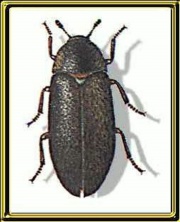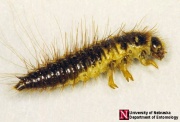Difference between revisions of "Hide beetle"
Jump to navigation
Jump to search
(username removed) |
(username removed) |
||
| Line 2: | Line 2: | ||
== Description == | == Description == | ||
| − | A beetle, ''Dermestes maculatus'', with a black back with a thin border of white hairs and a white abdomen with black spots. The hide beetle larvae eat bones, carcasses, [http://cameo.mfa.org/materials/fullrecord.asp?name=wool wool], [http://cameo.mfa.org/materials/fullrecord.asp?name=wood wood], [http://cameo.mfa.org/materials/fullrecord.asp?name=cork cork], and [http://cameo.mfa.org/materials/fullrecord.asp?name=insulation insulation]. The adult insects are about 9 to 10 millimeters long. They lay eggs that hatch in 2 to 4 days. The larvae have a black body with broad band in the center of its back. It grows in length to 12 mm. The larval stage lasts 35 to 238 days at which point a cocoon is formed. The adult hatches in 3 to 300 days and lives up to 3 months. The hide beetle is one of two species (the other is the [http://cameo.mfa.org/materials/fullrecord.asp?name=black | + | A beetle, ''Dermestes maculatus'', with a black back with a thin border of white hairs and a white abdomen with black spots. The hide beetle larvae eat bones, carcasses, [http://cameo.mfa.org/materials/fullrecord.asp?name=wool wool], [http://cameo.mfa.org/materials/fullrecord.asp?name=wood wood], [http://cameo.mfa.org/materials/fullrecord.asp?name=cork cork], and [http://cameo.mfa.org/materials/fullrecord.asp?name=insulation insulation]. The adult insects are about 9 to 10 millimeters long. They lay eggs that hatch in 2 to 4 days. The larvae have a black body with broad band in the center of its back. It grows in length to 12 mm. The larval stage lasts 35 to 238 days at which point a cocoon is formed. The adult hatches in 3 to 300 days and lives up to 3 months. The hide beetle is one of two species (the other is the [http://cameo.mfa.org/materials/fullrecord.asp?name=black%20larder%20beetle black larder beetle]) formerly used to clean bones in museums. |
[[File:Hide.beetle.larva.lat_Univ.Nebr.jpg|thumb|Hide beetle | [[File:Hide.beetle.larva.lat_Univ.Nebr.jpg|thumb|Hide beetle | ||
| Line 13: | Line 13: | ||
== Additional Information == | == Additional Information == | ||
| − | MuseumPests.net: [http://www.museumpests.net/pdfholder/27image.pdf Hide Beetle] | + | º MuseumPests.net: [http://www.museumpests.net/pdfholder/27image.pdf Hide Beetle] |
== Authority == | == Authority == | ||
| − | * | + | * Lynda A. Zycherman, J.Richard Schrock, ''A Guide to Museum Pest Control'', FAIC and Association of Systematics Collections, Washington DC, 1988 |
* Wikipedia, the free encyclopedia, at http://www.wikipedia.com Comment: http://en.wikipedia.org/wiki/Hide_beetle | * Wikipedia, the free encyclopedia, at http://www.wikipedia.com Comment: http://en.wikipedia.org/wiki/Hide_beetle | ||
Revision as of 06:33, 24 July 2013
Description
A beetle, Dermestes maculatus, with a black back with a thin border of white hairs and a white abdomen with black spots. The hide beetle larvae eat bones, carcasses, wool, wood, cork, and insulation. The adult insects are about 9 to 10 millimeters long. They lay eggs that hatch in 2 to 4 days. The larvae have a black body with broad band in the center of its back. It grows in length to 12 mm. The larval stage lasts 35 to 238 days at which point a cocoon is formed. The adult hatches in 3 to 300 days and lives up to 3 months. The hide beetle is one of two species (the other is the black larder beetle) formerly used to clean bones in museums.
Synonyms and Related Terms
skin beetle
Additional Information
º MuseumPests.net: Hide Beetle
Authority
- Lynda A. Zycherman, J.Richard Schrock, A Guide to Museum Pest Control, FAIC and Association of Systematics Collections, Washington DC, 1988
- Wikipedia, the free encyclopedia, at http://www.wikipedia.com Comment: http://en.wikipedia.org/wiki/Hide_beetle

